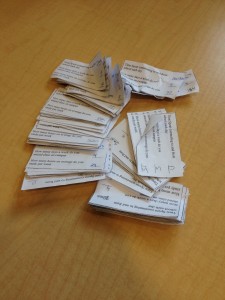Methodology
Our variables will be measured through the conduction of a class survey on Wednesday, March 19th because Duncan, the media technician, is coming to class to explain blogging. All students will be provided with the same set of questions prior to the beginning of the lecture:
1. Time spent commuting to and from school each day
2. How many days of the week they attend class on campus
3. How many hours on average they spend studying per week
Names and other personal information will not be obtained. Completed surveys will be collected at the end of class. Considerations have been made with regard to students who may be absent from class that particular day, and it has been decided that we will collect as many completed surveys as possible. For our study, we will consider all completed surveys in an effort to maximize our study’s validity. By taking every survey presented to us, we hope to have our sample represent our population as closely as possible. There is still potential for bias in your survey. For example, students with a longer commute are more likely to skip early classes such as LFS 252. Students who face some sort of hardship in the particular day you survey (i.e. sickness, another class’s deadline on that same day, etc.) are more likely to skip class if their commute also takes longer.
The survey was conducted on Wednesday, March 19, 2014. The date was chosen since more students are willing to attend class during the middle of week. Also, Duncan, a important speaker that was going to lecture the class on setting up a blog that was going to be used in the final delivery of the project. Therefore, we expected approximately 150 of the total 193 students to attend the lecture on that day, and expected approximately 100 surveys to be completed and returned.
It is impossible to ensure that every student will be able to answer the survey, but we have several methods in receiving the greatest amount of surveys possible. An announcement was made during the first few minutes of class explaining the class that we were conducting a survey.We had 3 group members standing outside the 3 main entrances to the lectures to hand out and receive the surveys. The 3 group members continued to stay near the entrances of lecture hall to hand out surveys to students that arrived late. Another 3 group members were inside the lecture hall to hand out additional surveys to students that did not receive them at the entrance, and to pick up the surveys after class had ended. This was to ensure that we can collect the surveys before the students decide to discard the samples.
Sample size
Due to the use of a convenience sampling method, there will be various sources of bias in our results; for example, students attending class may live closer than students who are absent, non-response in the event that students who receive surveys decide not to fill out or return them, and voluntary answers, which will only include the results from the students who are present and willing to participate. These surveys rely on self-reports from the students, therefore there is a chance that what they report is inaccurate. We will be doing convenience sampling because the class contains a relatively large number of subjects that could participate in our sample, and all group members are available to present and collect the data. Due to the absence of randomization, a greater standard error value may be expected (will differ more from the population’s parameters); this may be combated with larger sample sizes. There is also a significant chance that not all observations will be strictly independent, including friends who may live near each other, therefore conclusions may not be representative of the entire population

